Overview
In the fast-paced world of tech startups, many founders grapple with the challenge of establishing a strong brand identity. This can often feel overwhelming, as the pressure to stand out in a crowded market weighs heavily. The implications of not addressing this issue can be significant, leading to lost opportunities and diminished customer loyalty. However, there is hope. By focusing on essential strategies for effective branding, you can create a cohesive identity that resonates with your target audience.
Start by:
- Developing a clear mission statement that reflects your values and vision. This will serve as a guiding light for your brand, helping you navigate the complexities of the market.
- Establishing a unique brand voice, which is equally important; it allows you to connect authentically with your customers. Remember, your audience wants to feel understood and valued.
- Leveraging customer feedback to refine your approach, as this not only enhances engagement but also fosters loyalty among your target audiences.
As you embark on this journey, know that you are not alone. Many startup founders have faced similar challenges and have found success by embracing these strategies. Sharing personal stories and testimonials can further inspire and connect with your audience, reinforcing the idea that together, we can overcome obstacles. By nurturing your brand identity with empathy and understanding, you can create a lasting impact in the tech industry.
Introduction
In the competitive realm of technology startups, establishing a compelling brand identity can often feel like navigating a labyrinth. Many founders find themselves grappling with the challenge of standing out amidst a sea of innovation and noise, leading to feelings of uncertainty and doubt. This article explores seven essential strategies designed to empower tech entrepreneurs in crafting effective branding. These insights not only aim to enhance visibility but also foster genuine connections with your target audience.
How can startups transform their branding approach to not only survive but truly thrive in an ever-evolving market landscape? Together, let’s discover the path forward.
RNO1: Comprehensive Branding and Identity Services for Tech Startups
In the fast-paced world of technology ventures, many founders face the daunting challenge of establishing strong branding. This struggle can often lead to feelings of isolation and uncertainty as they navigate a competitive landscape. At RNO1, we understand these pain points deeply, and we are here to help.
Our range of is thoughtfully designed to support technology startups in their journey. We offer:
- Strategy development
- Logo design
- Digital identity creation
- Go-To-Market Strategy
All tailored to elevate purpose-driven companies. By leveraging our expertise, new ventures can build a robust foundation for their branding that resonates with their target audience and sets them apart in the marketplace.
We believe that should reflect the vision and goals of the venture. Our ensures a cohesive identity from the very beginning, fostering a unified presence that speaks to the heart of the audience. We are committed to to becoming a collaborative partner in your digital growth. Through our Return On Design & Digital (RODD) strategies, we maximize branding marketability, helping you realize your dreams.
At RNO1, we are not just here to provide services; we are here to walk alongside you, nurturing your vision and empowering your journey. Together, we can create a branding identity that not only stands out but also connects with the people who matter most.
Customer Personas: Define Your Target Audience for Tailored Branding
Developing comprehensive can feel daunting, yet it is a crucial step for striving to enhance their branding. Many founders face the challenge of connecting with their audience, often feeling lost in the vast sea of potential clients. By identifying key demographics, preferences, and pain points, startups can tailor their to genuinely resonate with their target audience. This focused approach not only but also fosters a sense of loyalty, as individuals feel genuinely understood and appreciated.
It's essential for startups to conduct thorough and utilize analytics tools to gather insights that shape their audience personas. Given that a staggering 9 out of 10 startups face failure, grasping the nuances of their audience becomes vital for crafting . As Rocío Arrarte wisely points out, effective branding hinges on , underscoring the importance of . This understanding is not merely a strategy; it is a pathway to connection and trust.
Moreover, the commitment to nurturing relationships extends beyond the initial sale. Chet Holmes emphasizes the of , reminding us that ongoing efforts in this direction can yield profound rewards. By embracing these practices, startups can not only survive but thrive, creating a community of loyal clients who feel valued every step of the way.
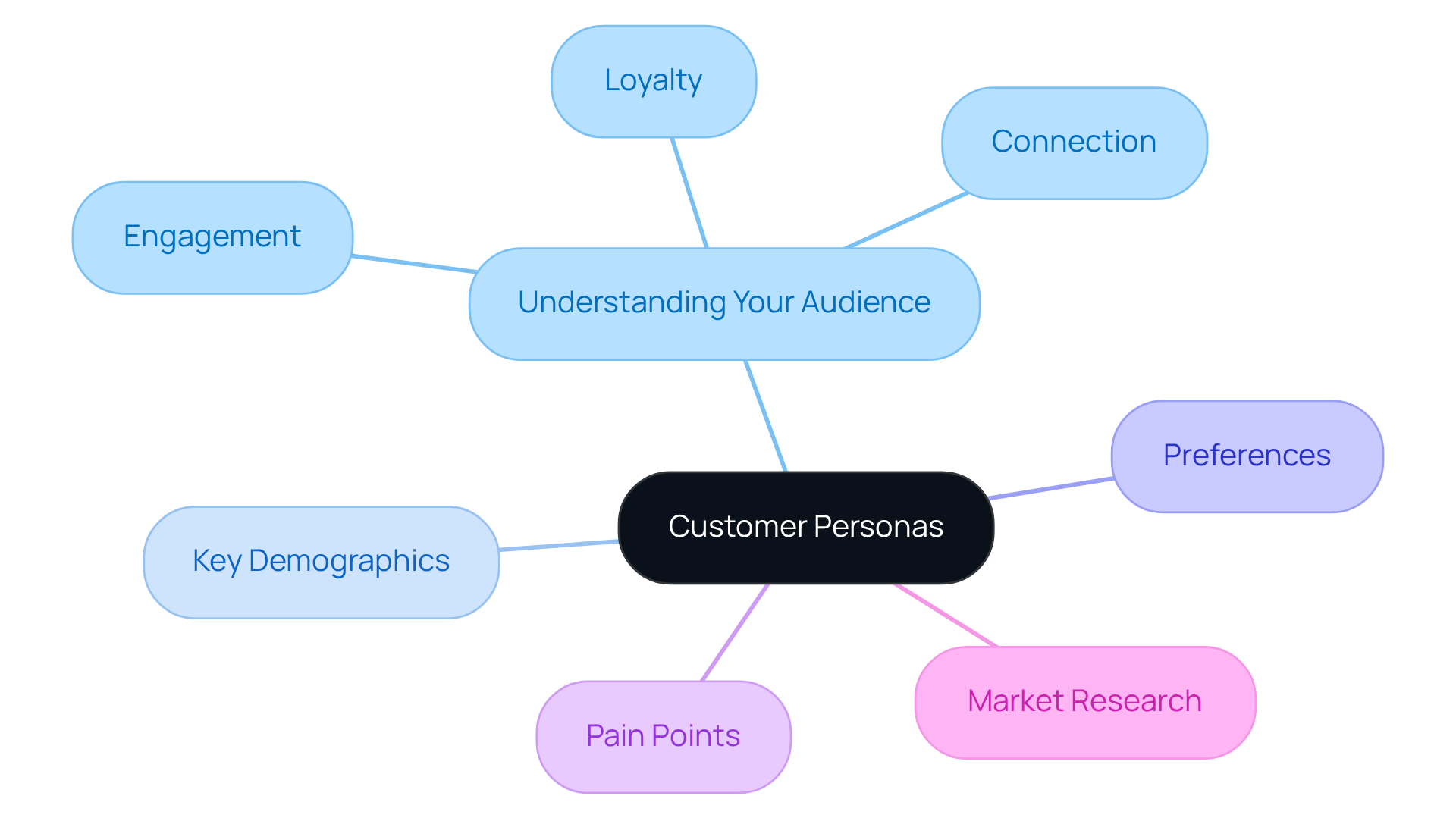
Mission Statement: Articulate Your Brand's Purpose and Values
A well-crafted articulates the core purpose and values of a technology company, serving as a foundational element for branding and marketing strategies. However, many grapple with clearly defining this essential component, leading to a disconnect in their messaging. This inconsistency can create confusion and diminish the impact of their branding. By addressing this challenge, startups can that resonates deeply with their audience.
A powerful mission statement not only draws clients but also motivates employees and stakeholders, nurturing a sense of collective purpose and dedication. When individuals see their values reflected in a company, loyalty flourishes, and they are more inclined to engage. Successful tech firms exemplify this method, showing how a focused can enhance both internal motivation and external reputation.
For instance, the demonstrates a commitment to empowering contemporary founders for digital success, achieving a 30% and a 25% boost in brand loyalty within six months. Jared Schwitzke and Leigh Ann Tucker have praised RNO1 for its and , illustrating how a clear mission can transform branding.
To create an , tech founders should consider aligning their with their industry impact, ensuring that their mission resonates with both their team and their target audience. Remember, you are not alone in this journey; by focusing on your mission, you can inspire those around you and build a community that shares your vision.
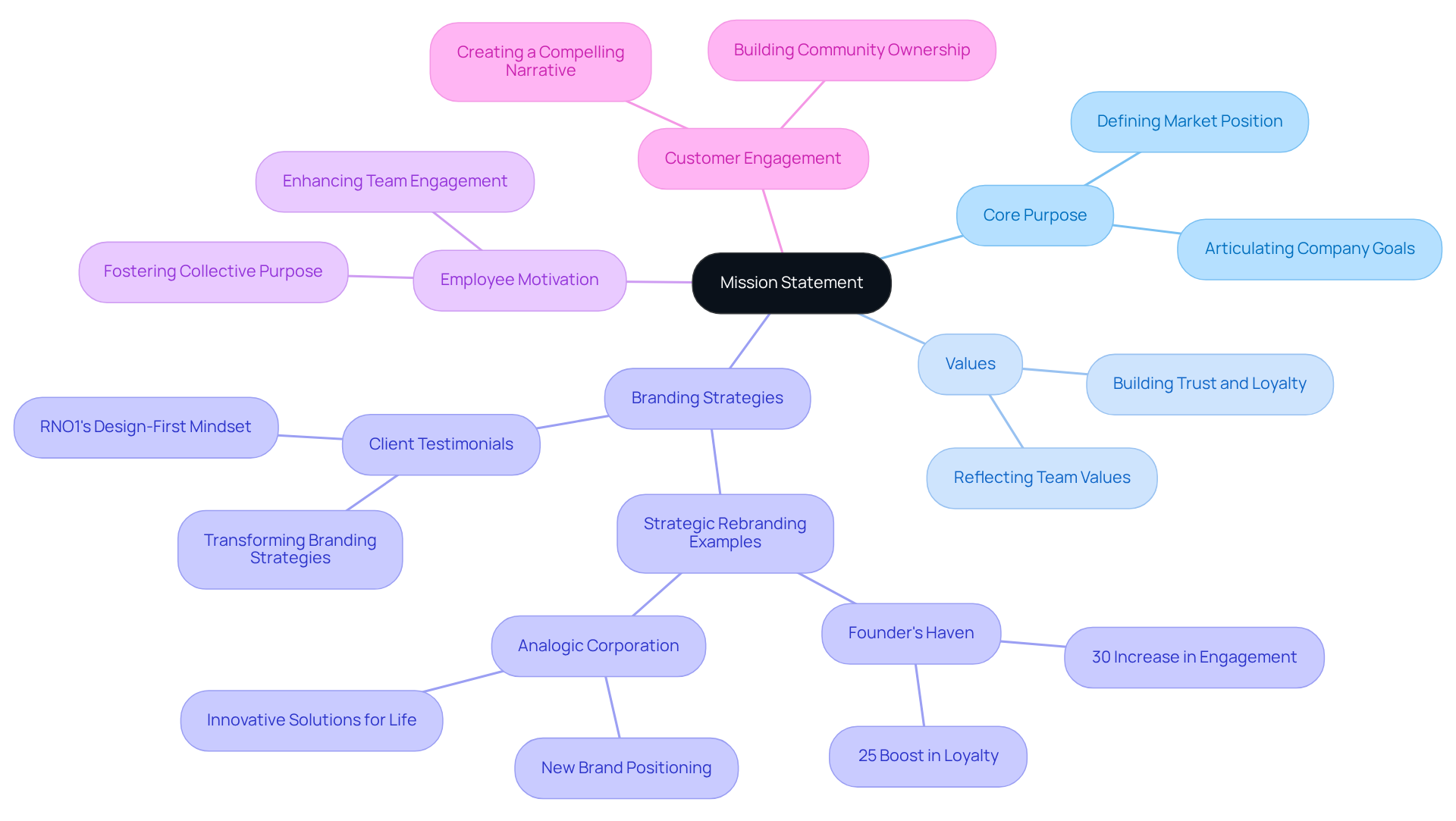
Brand Voice: Establish a Unique Tone to Connect with Your Audience
Cultivating a unique can be a significant challenge for tech startups seeking to connect authentically with their audience. When this voice reflects the branding's personality and values—be it professional, friendly, or innovative—it becomes a vital asset. At RNO1, we understand this journey and emphasize a across every interaction, ensuring that our voice resonates with our commitment to .
We encourage startups to create guidelines outlining their tone, language, and style, as this consistency across all is essential. By embracing innovative strategies, such as our , which expands omnichannel ambassador programs, new businesses can enhance their through influencer collaborations.
A powerful voice in branding fosters familiarity and trust, which nurtures . Remember, you’re not alone in this process; we’re here to support you every step of the way.
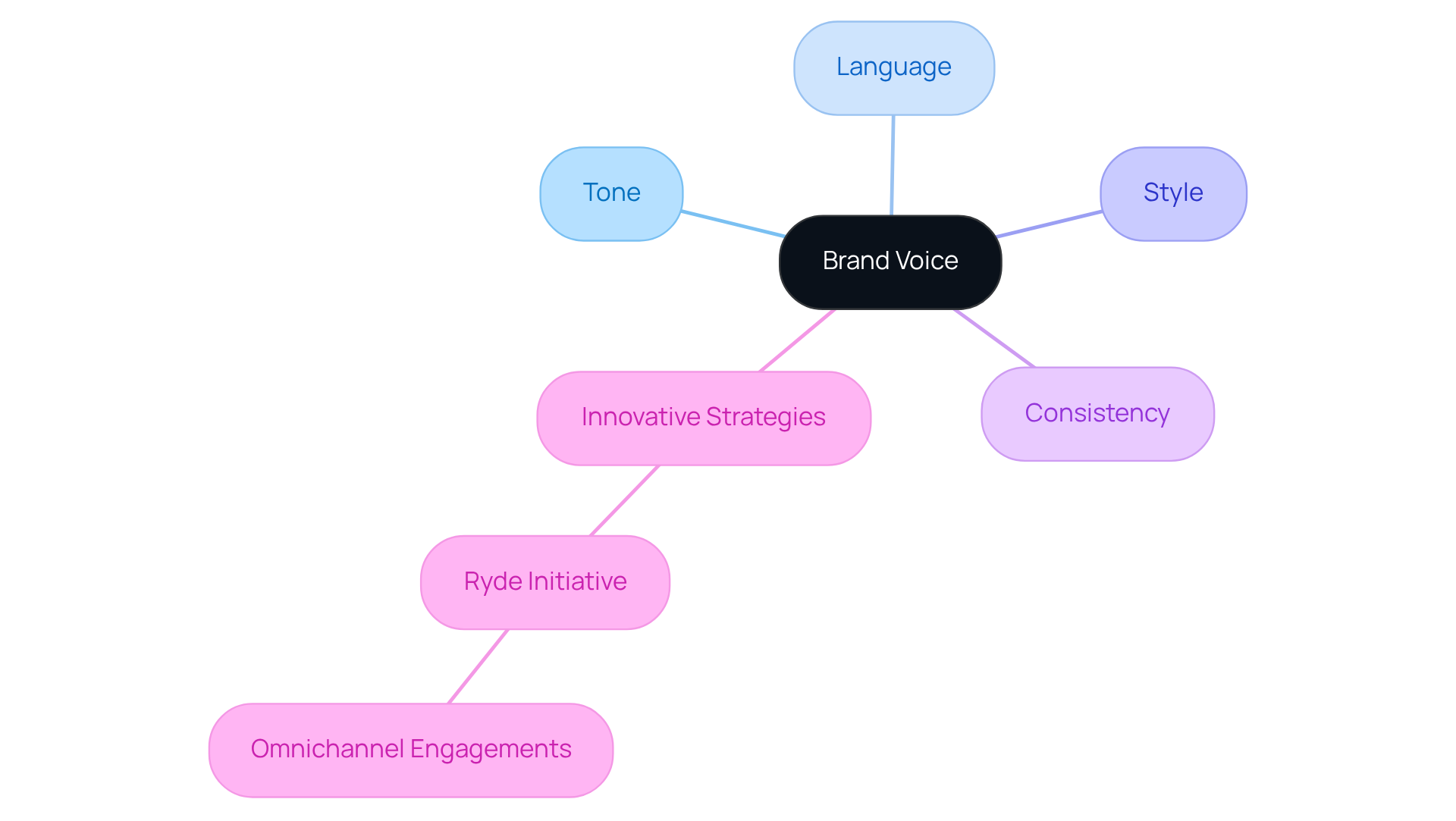
Brand Story: Craft a Narrative that Resonates with Your Audience
Creating an engaging is crucial for technology companies seeking to connect with their audience. Many startups struggle to share their story, which can lead to feelings of isolation in a crowded market. This narrative should outline the company's beginnings, the obstacles encountered, and the ambitions that propel its purpose, with clients.
By sharing genuine experiences and core values, startups can effectively distinguish themselves. A well-articulated narrative not only captivates clients but also plays a crucial role in branding, transforming them into passionate supporters for the company.
For example, of Founder's Haven demonstrates how a focused narrative can empower contemporary founders for , resulting in enhanced brand recognition and loyalty. , such as Airbnb's journey from renting air mattresses to a global platform, illustrate that effective can significantly enhance and loyalty.
As psychologist Jerome Bruner noted, people are 22 times more likely to remember details when stories communicate messages rather than just facts and numbers. Furthermore, testing and validating the story with diverse audiences is crucial, as it ensures the narrative resonates well and can be refined based on feedback.
Distributing the business narrative widely is essential for branding, as it establishes recognition and connection, fosters a sense of purpose, and inspires trust, which is vital for long-term success. Remember, your story matters, and sharing it can create a .
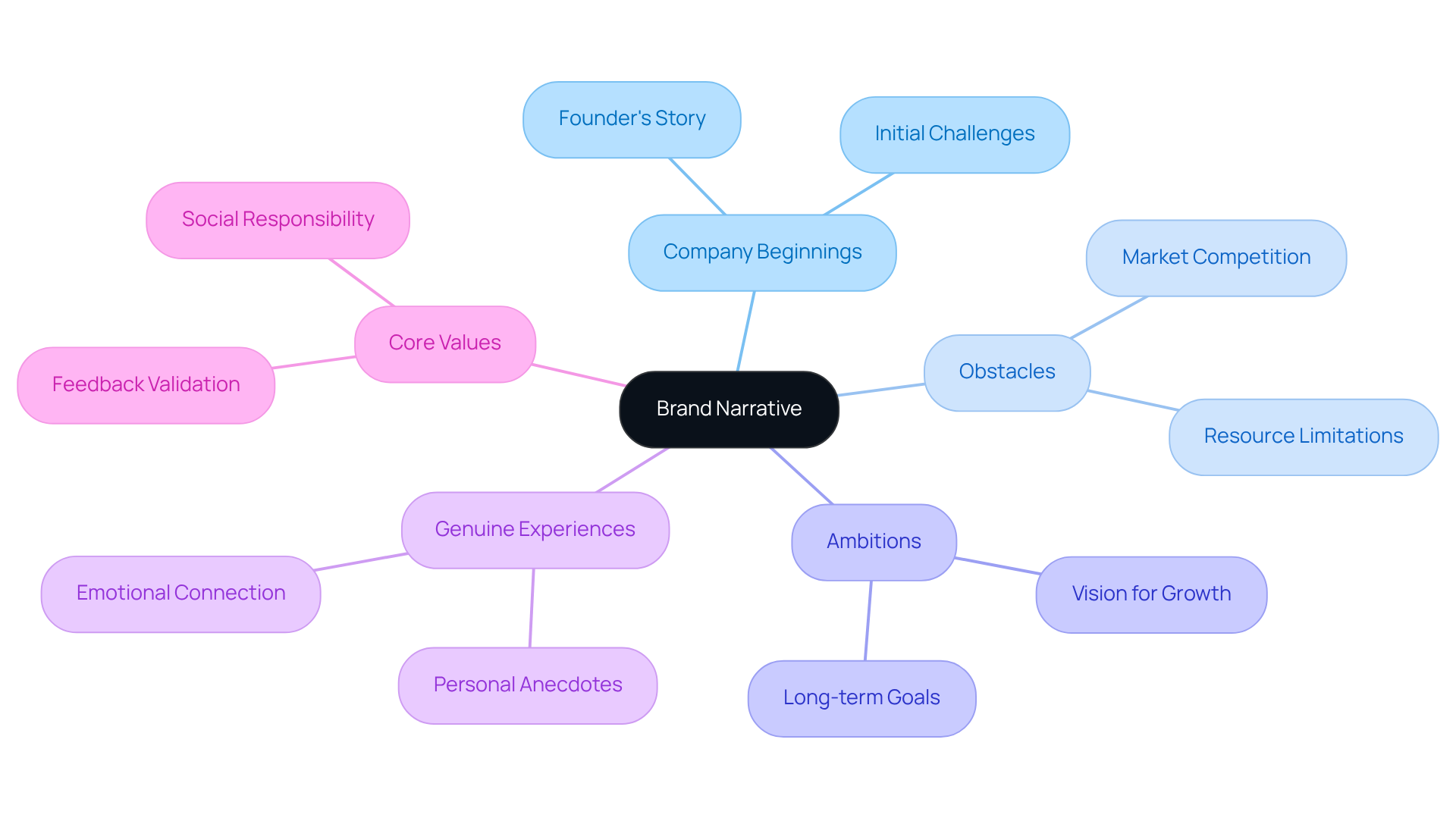
Visual Identity: Design Memorable Logos and Color Palettes
In today's rapidly changing digital landscape, tech startups often face the challenge of creating a memorable that truly stands out. This can be a daunting task, as the pressure to differentiate oneself is ever-present. However, addressing this challenge is crucial for the success of your .
To help you navigate this journey, consider these key elements:
- Distinctive Logo: A logo that encapsulates the essence of your brand can make all the difference. It should resonate with your audience and reflect your values.
- Cohesive Color Palette: Choosing colors that embody your identity is vital. These colors should connect with your target audience, evoking the emotions you wish to convey.
- Typography: Establishing typography that enhances readability while aligning with your brand's voice is essential. It should be inviting and reflective of your personality.
At RNO1, we understand the across all platforms—from your website to social media. A robust visual identity not only boosts recognition but also enhances branding by effectively communicating your organization's values and mission. By highlighting and digital experiences, particularly for emerging businesses in e-commerce and , we aim to support you in with your audience.
Remember, you are not alone in this journey. We are here to , ensuring that your visual identity not only stands out but also reflects the heart of your brand.
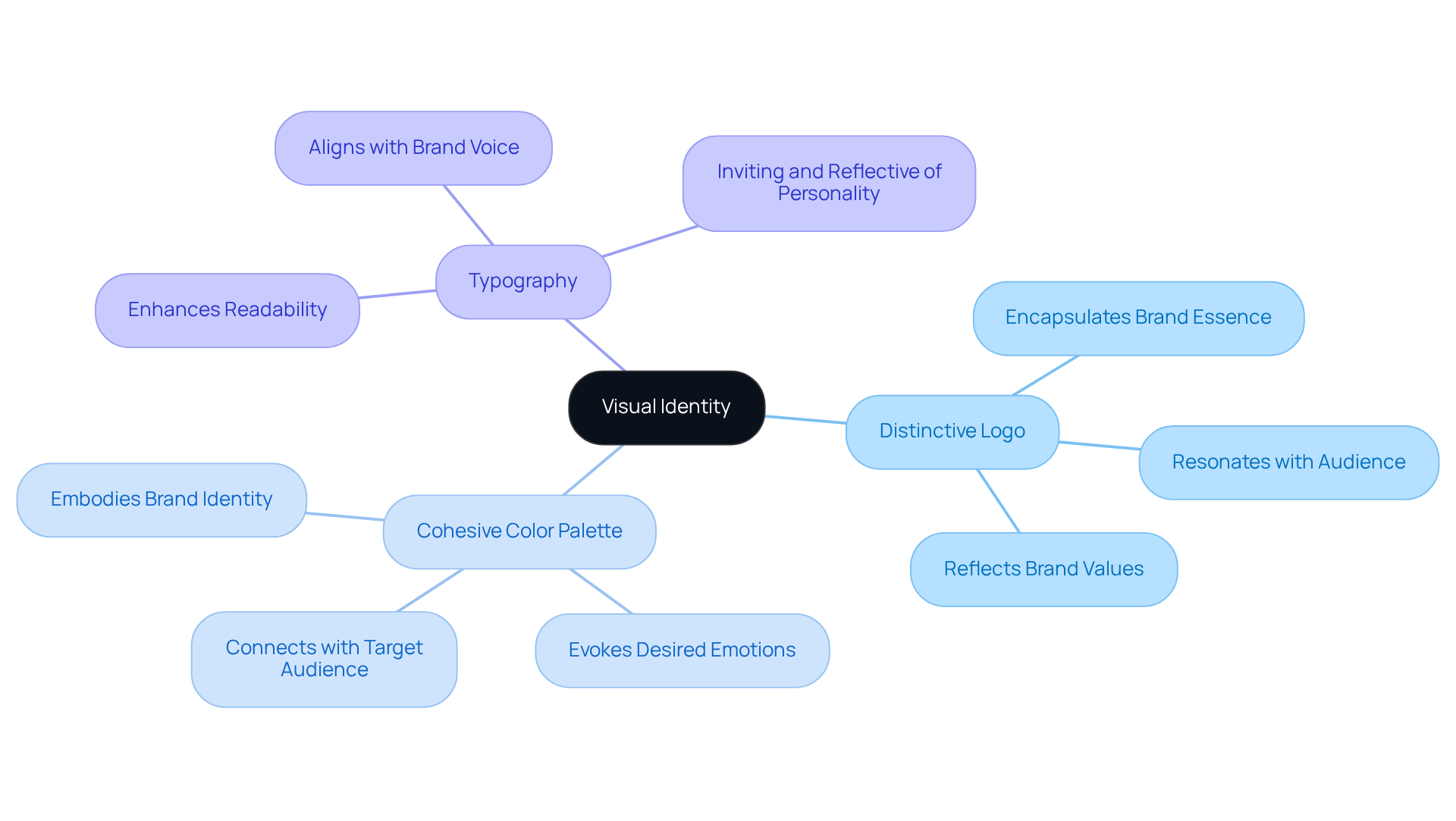
Brand Consistency: Ensure Uniformity Across All Platforms
For tech startups, maintaining consistency across all platforms can feel like a daunting challenge. The struggle often lies in ensuring that the voice, visual identity, and messaging remain uniform across websites, social media, and marketing materials. This inconsistency can lead to confusion and uncertainty among customers, who may find it difficult to know what to expect from the company. It’s understandable to feel overwhelmed by this responsibility, especially when you want to and build in your brand.
Imagine a potential customer visiting your website, only to find a different tone on your social media channels. This disconnect can erode their confidence in your branding. Customers thrive on familiarity, and when they see a , it fosters a sense of trust and reliability. To , startups can benefit from creating clear guidelines that outline how to implement their identity elements across various channels. This not only ensures a but also empowers your team to communicate with clarity and confidence.
By taking these steps, you can cultivate a unified presence that resonates with your audience and reinforces their trust in your brand. Remember, you’re not alone in this journey; many founders share similar experiences and challenges. Together, we can create a where your startup can thrive and connect meaningfully with your customers.
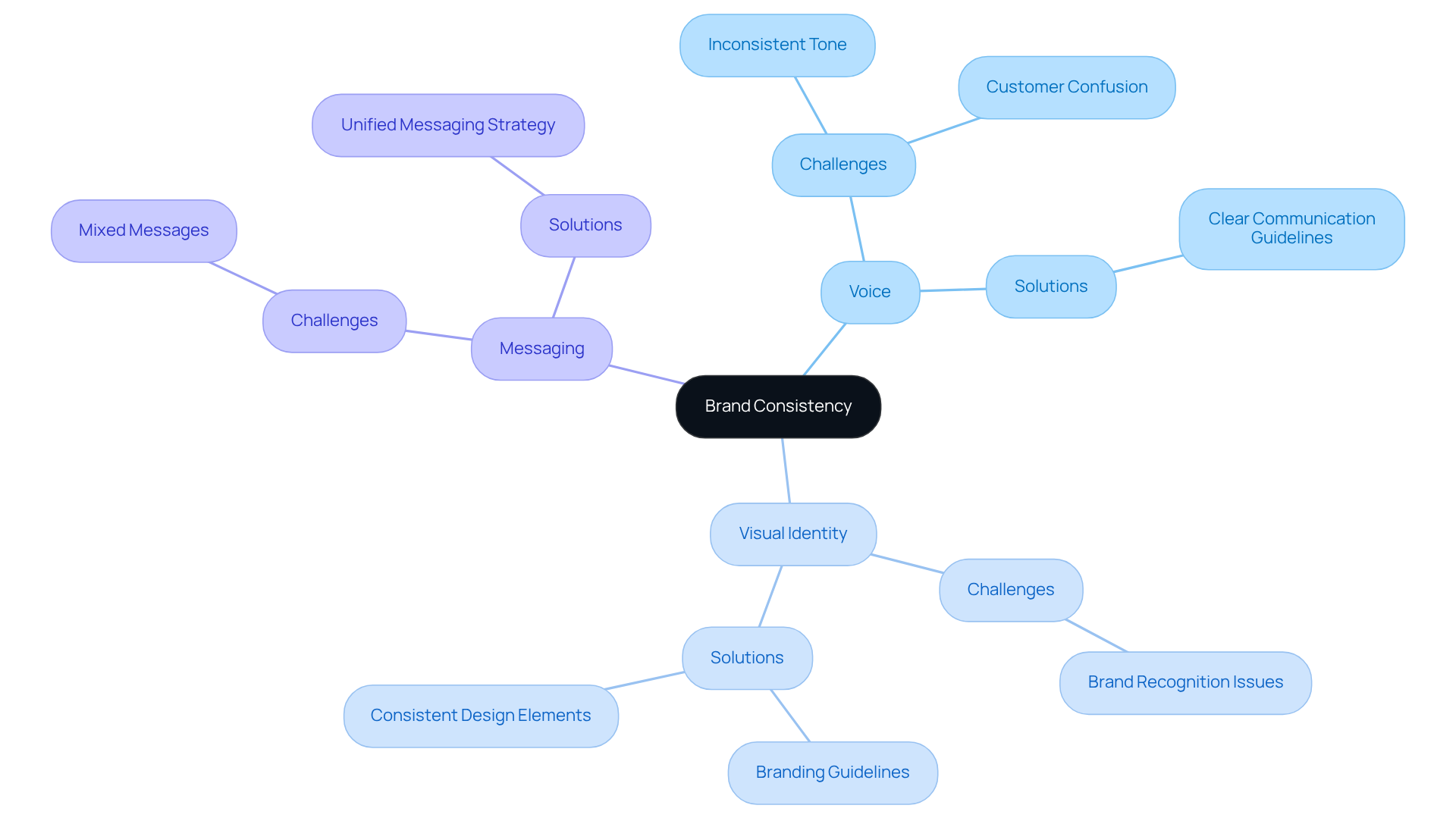
Performance Marketing: Boost Your Brand's Visibility and Engagement
For technology companies, enhancing visibility can often feel like a daunting challenge. Many founders grapple with the overwhelming task of cutting through the noise in a crowded marketplace. This struggle can lead to feelings of frustration and isolation, as they strive to effectively. The good news is that there are proven that can help.
By embracing strategies such as:
- Pay-per-click advertising
- Social media marketing
- Search engine optimization
tech startups can significantly improve their outreach. However, it’s essential to think beyond traditional methods. Innovative approaches, such as scaling omnichannel branding ambassador programs, can create deeper connections with potential customers. For instance, showcases how collaboration with influencers and community-focused campaigns can foster genuine engagement and enhance .
As you navigate these marketing waters, remember that focusing on is crucial. Measuring the success of your campaigns not only allows for necessary adjustments but also optimizes your marketing efforts to improve engagement and visibility. You are not alone in this journey; with the right support and strategies, you can and connect meaningfully with your audience.
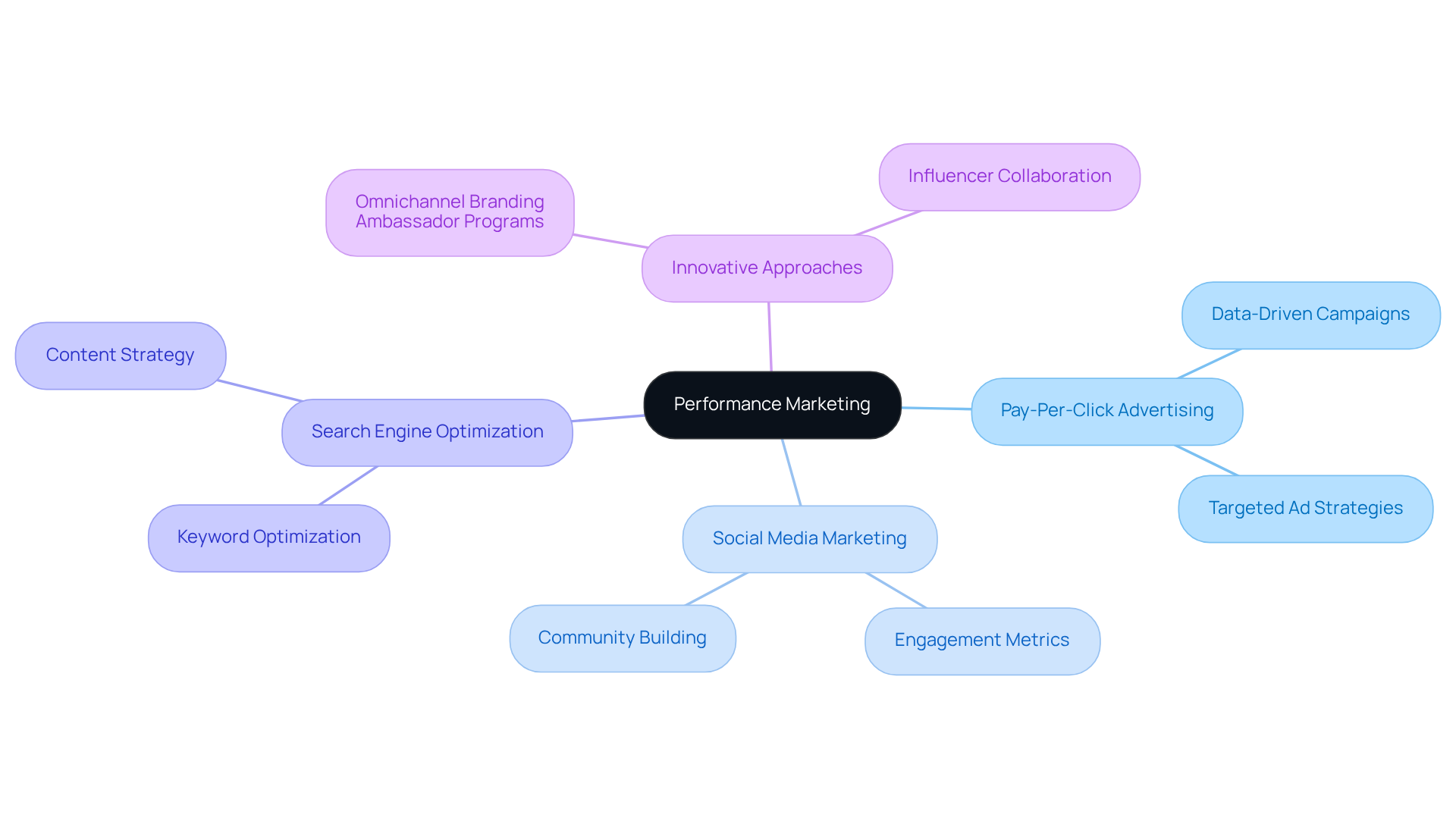
Customer Feedback: Leverage Insights to Refine Your Branding Strategy
For tech startups, the challenge of effectively can feel overwhelming. Many founders struggle to in a way that truly resonates with their audience. The story of Founder's Haven exemplifies how understanding user perceptions can empower contemporary founders towards digital success. By actively seeking feedback through surveys, social media interactions, and reviews, this organization discovered vital preferences and pain points of its clients. This insightful analysis enabled them to make , ensuring a deeper connection with their audience.
Imagine the relief that comes when a company implements changes based on client suggestions. Founder's Haven experienced a significant rise in brand loyalty and trust as a result. By demonstrating attentiveness to client insights, , new businesses can . It is through this nurturing engagement that but thrive in a competitive landscape.
We invite you to reflect on your own experiences. How has client feedback shaped your journey? By embracing these insights, you too can enhance your branding presence and cultivate a community around your vision. Remember, in this journey, you are not alone; every step of the way.
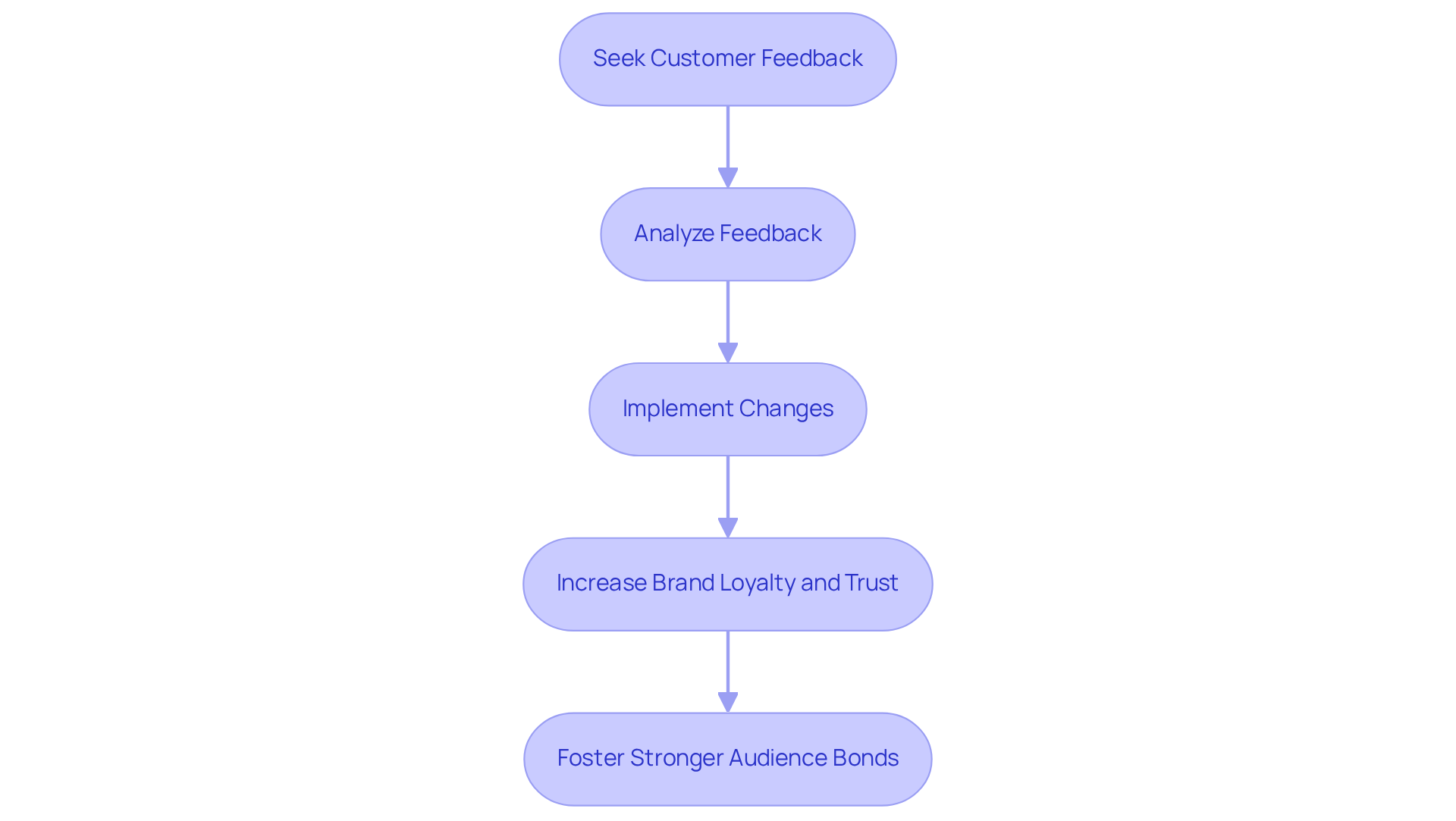
Market Adaptation: Evolve Your Branding to Stay Relevant
Tech startups often find themselves facing the daunting challenge of adapting their branding to remain relevant in a swiftly changing market. This can feel overwhelming, as it involves closely monitoring industry trends, understanding customer preferences, and navigating competitive landscapes to uncover opportunities for growth. The pressure to keep up can weigh heavily on founders, but there is hope.
Innovative strategies, such as , can provide a lifeline. For instance, showcases how enhancing through influencer partnerships can make a significant difference. By embracing and implementing —like those seen in the Ryde initiative—new ventures can breathe new life into their messaging and visual identity.
This adaptability is crucial to ensure that and meets their evolving needs. Therefore, it’s essential for startups to remain agile and responsive. As a supportive next step, consider developing your own user-generated content initiatives. This not only fosters community involvement but also , creating a nurturing environment that encourages growth and connection.
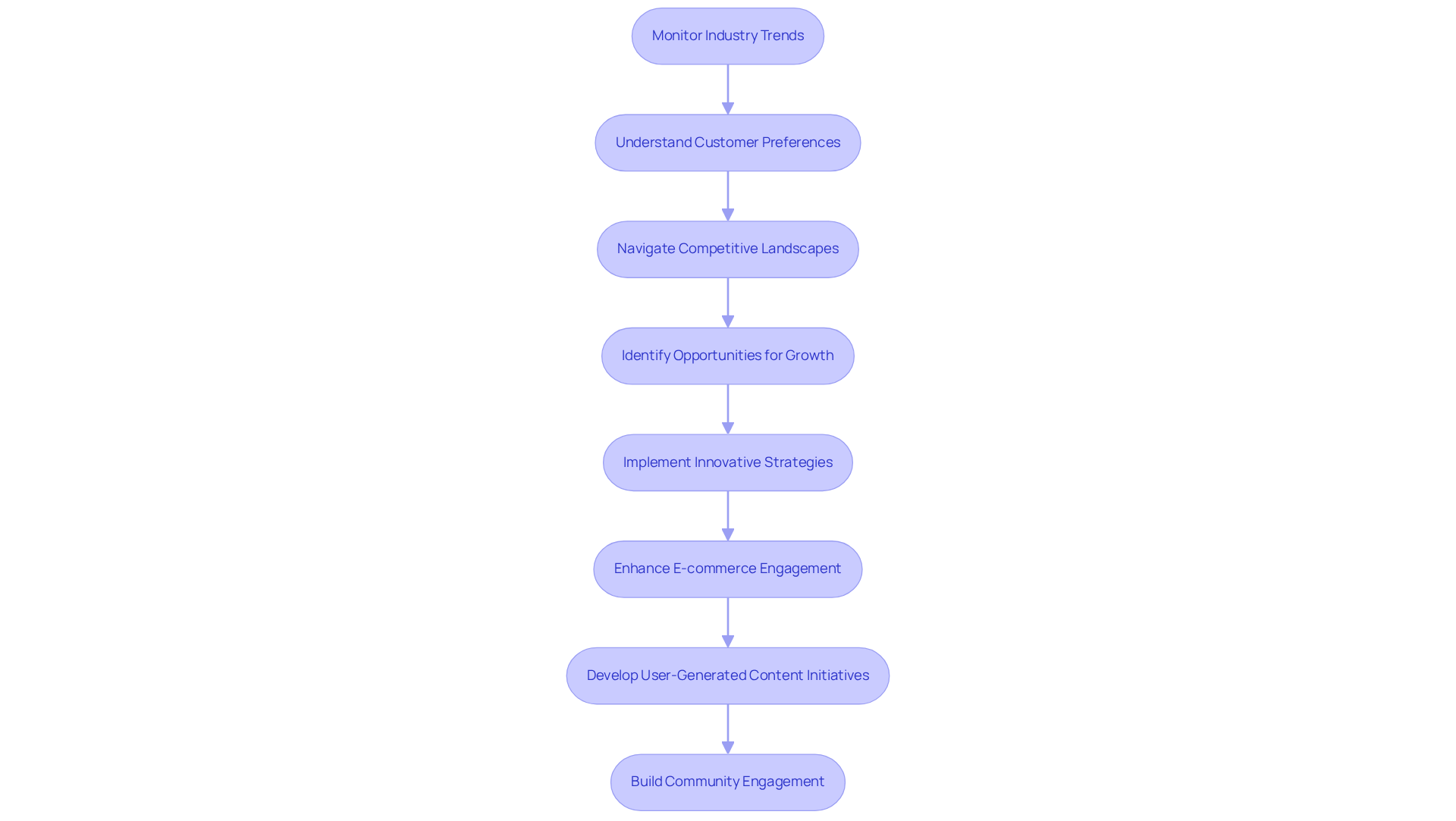
Conclusion
Effective branding is a crucial challenge for tech startups striving to find their unique place in a crowded market. Many founders feel overwhelmed by the competition and uncertain about how to connect with their audience. This struggle can lead to feelings of doubt and frustration. However, by embracing comprehensive strategies—such as:
- Developing customer personas
- Articulating a clear mission statement
- Establishing a distinctive brand voice
startups can create a cohesive identity that truly resonates with their audience. These foundational elements not only enhance visibility but also foster trust and loyalty among clients, transforming uncertainty into confidence.
Throughout this article, we have explored key strategies that can make a significant difference in your branding journey. These strategies include:
- Crafting a compelling brand story
- Designing memorable visual identities
- Maintaining brand consistency
- Leveraging customer feedback for continuous improvement
Each of these elements plays a critical role in ensuring that your branding remains relevant and impactful in an ever-evolving market. Remember, you are not alone in this process; many have walked this path and found success.
In conclusion, branding for tech startups is not just about standing out; it’s about forming deep connections with your audience and nurturing lasting relationships. By implementing these strategies and staying adaptable to market changes, you can cultivate a strong brand presence that not only survives but thrives. Embrace the power of effective branding to transform your vision into a reality. And remember, support is available to guide you through every step of this vital process. Together, we can navigate this journey and celebrate your successes.
Frequently Asked Questions
What services does RNO1 provide for tech startups?
RNO1 offers a range of branding services including strategy development, logo design, digital identity creation, and go-to-market strategy, all tailored to support technology startups.
How does RNO1 approach branding for startups?
RNO1 focuses on creating a cohesive branding identity that reflects the startup's vision and goals. They aim to transform their role from a vendor to a collaborative partner in the startup's digital growth.
Why is developing customer personas important for tech startups?
Developing customer personas helps startups connect with their audience by identifying key demographics, preferences, and pain points. This focused approach enhances engagement and fosters loyalty among potential clients.
What role does market research play in defining customer personas?
Market research and analytics tools are essential for gathering insights that shape audience personas, which are crucial for crafting impactful marketing campaigns.
What is the significance of a mission statement for a tech startup?
A well-crafted mission statement articulates the core purpose and values of a tech company, serving as a foundational element for branding and marketing strategies. It helps create a compelling narrative that resonates with the audience and motivates employees.
How can a strong mission statement impact a startup?
A powerful mission statement can draw clients, motivate employees, and nurture loyalty among stakeholders. It aligns the company's values with its audience, enhancing both internal motivation and external reputation.
Can you provide an example of successful rebranding?
The strategic rebranding of Founder's Haven is an example, where they achieved a 30% increase in customer engagement and a 25% boost in brand loyalty within six months by focusing on empowering contemporary founders for digital success.
What should tech founders consider when creating a mission statement?
Tech founders should align their core values with their industry impact, ensuring that their mission resonates with both their team and their target audience.




